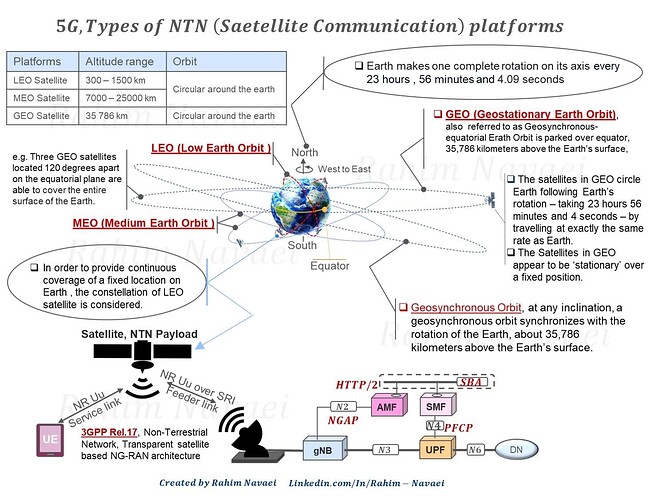-
Geostationary (GEO) satellites: located precisely in the plane of the Equator at an altitude of 35,786 km, these satellites rotate at the same rate as the Earth’s rotation.
- A GEO satellite stands still with respect to Earth Thanks to this property, a single GEO satellite is sufficient to create a continuous coverage.
-
Non-Geostationary Orbiting (NGSO) satellites: These satellites do not stand still with respect to Earth.
- To provide service continuity over time, a number of satellites (a constellation) is required to meet this requirement. The lower the altitude of NGSO satellites, then the higher the number of NGSO satellites that are needed.
-
The different classes of NGSO satellites:
-
Low-Earth Orbiting (LEO) satellites: satellites typically deployed in constellations with altitude ranging from 500 km to 2,000 km, You can also find the range from 300 km to 1500 km.
-
Medium-Earth Orbiting (MEO) satellites: with altitude ranging from 8,000 to 20,000 km. You can also find the range from 7000 km to 25000 km.
-
Highly-Eccentric Orbiting (HEO) satellites: satellites with a range of operational altitudes between 7,000 km and more than 45,000 km.
-
-
With NGSO satellites, the 5G Base Station (gNB) can provide either quasi-Earth-fixed service link or Earth-moving service link, while gNB operating with GSO satellite can provide Earth fixed service link.
-
A constellation of LEO and MEO is used to provide services in both Northern and Southern hemispheres.
- In some case, the constellation can even provide global coverage including polar regions.
-
With NGSO satellites, the 5G Base Station (gNB) can provide either quasi-Earth-fixed service link or Earth-moving service link, while gNB operating with GSO satellite can provide Earth fixed service link.
-
Here I try to depict different classes of orbits for GSO and NGSO satellites.
LinkedIn:
